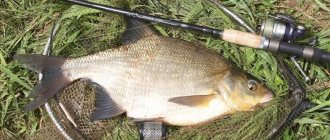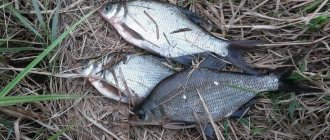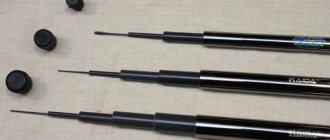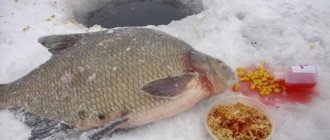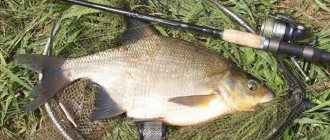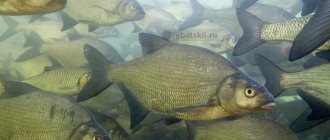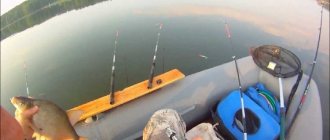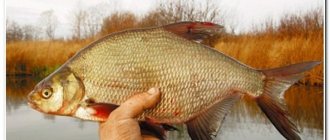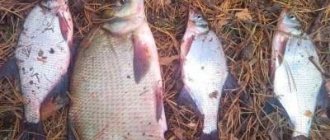Where to look for bream and how to catch it
Before you go fishing for bream in the summer, you need to find out where these fish live. Experts say that in Russia bream can be found in almost every body of water; they are found in both small and large lakes.
Since the water in the rivers subsides at the end of June (month 6), most fish go to the bottom, and bream and bream are no exception. The best option is if during the day fishing will be carried out in a pool or deep holes. But if a fisherman plans to fish at night, it is necessary to take into account that after midnight the fish will rise to shallow sections of the river, since it is easier to find food there. That is why, in order for the chances of success to be maximum, the fisherman needs to choose a place in advance, prepare everything, and go fishing in the evening. It is also necessary to take into account that bream can go into shallow water depending on the type of reservoir.
Many anglers are also interested in what to use to catch carp fish in early June–late July.
The best option is to use gear that is most suitable for a particular body of water. Much depends on what kind of equipment the fisherman is used to.
You can catch bream using the following gear:
- ordinary donka;
- a fishing rod equipped with a rubber shock absorber;
- feeder;
- float rod;
- ringing
What matters more is not the rod itself, but the bait used. Ichthyologists recommend paying maximum attention to the preparation of complementary food; if the mixture is prepared correctly, the fisherman will be able to lure a large number of both large and small individuals.
Summer fishing techniques and tactics
Experienced fishermen know that different bodies of water have their own subtleties. Depending on the fishing location, choose bait, feeding and tackle. Success depends on the number of rods and hooks on them, on the quality and type of bait. When fishing from the shore, it is recommended to place gear at dusk, since at dawn the fish are less careful. At the same time, you should behave as quietly as possible so as not to scare away the potential catch.
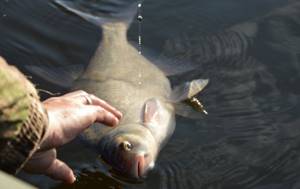
Tackle
To choose good tackle, it is advisable to familiarize yourself with the design features of each fishing rod. It is important to assemble it correctly, to select parts that correspond to the behavior of the object being caught. The bream, swallowing the bait, does not drown it, but leads it to the side. In addition, each tackle is different in its effectiveness in still water and in currents.
Familiarize yourself with the features of catching grass carp in summer.
Bottom fishing rod
The tackle is good on bodies of water with standing water or with a weak current - a lake or a shallow calm river, a pond. A fishing rod with a rubber shock absorber or, as it is popularly called, “rubber band” is effective for fishing.
For bream, the structure is assembled from the following parts:
- fishing line 0.2–0.4 mm thick;
- fishing rubber;
- leashes up to 60 cm long;
- hooks No. 5–7;
- sinker;
- bell.
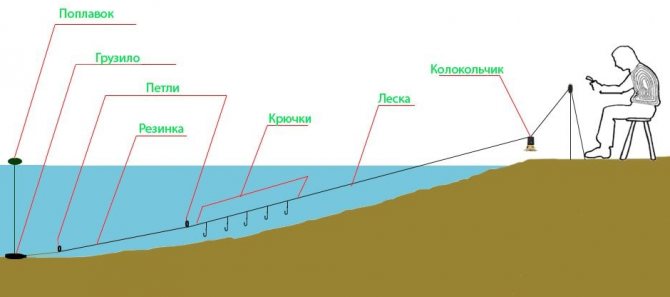
Feeder
The feeder is preferred by lovers of night fishing. Its design is practically no different from the donkey. Instead of rubber, a hard rod up to 4 m in length is used. The fishing line is wound onto a reel, eliminating the tangling of the gear. To these parts they also add a feeder weighing about 90 g. The fishing line and hooks are taken in the same sizes as for the donk. The advantage of a feeder is the ease of casting and a faster change of bait or hook in case of a break.
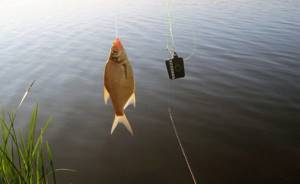
What to use as bait
Bream fishing in June is traditionally carried out using maggots or bloodworms (you can also use regular worms). In summer, breams can also bite on plant foods.
Most fishermen choose as bait:
- dry pearl barley;
- corn kernels;
- peas;
- semolina porridge;
- raw dough;
- boiled potatoes;
- pasta;
- bread crumb.
If fishing is carried out in a reservoir located near a village or any other residential area, the bite with standard bait can be very bad due to the fact that the fish will be fed. In this case, it is much wiser to prepare for fishing in advance and prepare a special bait.
The bait for bream, which is prepared as follows, has proven itself very well:
- first you need to put a small grain of corn on the hook;
- then attach the pasta to it (you need to choose a flour product that will definitely not disintegrate when it gets into water);
- the last ingredient is 2 maggots.
The amount of bait is selected depending on the size of the hook and how large the fish are in the pond. Many anglers also add various flavors to their baits to achieve maximum results.
If the product is chosen correctly, the fish may be even more interested in it than in live maggots.
Lures and groundbait for bream
For successful fishing, bream, like other fish, should be fed in the future fishing areas. In this case, you can use both plant and animal baits, or artificial, synthetic compounds.
Vegetable baits
- With regard to vegetable complementary food and bait for bream, it can be corn and pearl barley, peas or dough, up to pasta and boiled potatoes, or simple wheat bread crumb.
- But as experienced fishermen note, when catching bream, it is best to make a “sandwich” on your hook. First, they put a corn grain on a hook, then a star-shaped pasta and 1-2 maggots on top - many people use this bait to lure picky inhabitants of rivers and reservoirs.
Animal bait
If possible, it is best to catch bream either with a mixed bait, as described above, or use animal bait.
And this can be:
- Earthworms are the most common bait, and getting them is not difficult. They are placed so that a bunch is formed on the hook, but without stringing the worm along the axis of its body.
- Maggots are small, mobile worms with a specific smell that stick well to the hook. For bait, put on from 3 to 7 maggots.
- Bloodworms are dark worms, mosquito larvae, often used by anglers in fishing. Like maggots, they should be put on a hook in a bunch, specially tied with an elastic band or thread.
Artificial baits
Of the artificial baits, it is optimal to use crumbled polystyrene foam, used as an independent bait and to raise the hook to the surface of the water.
In addition, it gives the hook vibrations that are attractive to bream, which is especially effective when the water is flowing.
Note! As an option, you can also use pellets made from dough - it is attached to the hook with thread. And when fishing for spruce, they use a leash from 1 to 3 meters - the effectiveness of the bait increases significantly.
Flavor selection
To prevent bream fishing in June from ending in failure (especially if fishing is in an unfamiliar place), experts recommend not taking risks and still purchasing suitable bait in the store. There is a wide range of similar products on sale today; they all differ not only in composition, but also in price category. Since most of these baits work almost the same way, you can choose virtually any product.
Experienced fishermen advise beginners to use the following flavors in the summer:
- strawberries, cherries (any sweet berries are ideal);
- vanilla;
- cinnamon;
- caramel;
- honey.
Anise drops are considered a classic bait - this product, which has a specific smell, allows you to attract the attention of a wide variety of fish, and not just bream and bream.
It is extremely problematic to say which bait (store-bought or home-made) the fish bite better, since much depends on the conditions of the reservoir and the weather. A proven composition is the so-called Salapin porridge, all the ingredients in which are ideally combined not only in taste, but also in texture. If you add flavoring to the “Salapin” porridge, not a single fish will swim past such bait.
Lure
A hungry bream is a real glutton; it will eat until it has a hook in its mouth. Therefore, June fishing is not complete without bait. This is the most important component of such fishing; it stops the bream, makes it hungry, makes it compete for food with its relatives and forget about caution.
The easiest choice of bait is to buy a suitable mixture with the inscription “BREAM” in a fishing store. On the packaging you can also read recommendations regarding its use. An alternative option is to prepare your own bait from available ingredients. Its basis can be various porridges, sunflower cake, breadcrumbs, wheat bran. The mixture must contain large fractions, such as peas or corn. The effectiveness of bait largely depends on its aroma. In summer, bream can be seduced by the smell of vanilla, honey, strawberry or chocolate; for this purpose, appropriate flavors are added to the bait.
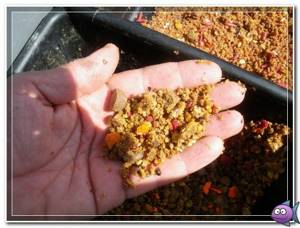
Daytime bream fishing
In some reservoirs, it is better to catch bream in June during the day. No matter how surprising it may be, in hot weather the fish are more actively looking for food in the daytime, and not at night or in the evening.
Experts advise anglers to adhere to the following rules:
- If over the past few days the fish have practically not bitten in the morning and at night, the likelihood that the bream bite will be good during the day increases significantly. Such changes in fish habits can be caused by weather conditions or the characteristics of the reservoir.
- The place for fishing needs to be chosen carefully; the ideal option is to find an area with a relatively shallow depth (up to a maximum of 3.5 m in depth) so that it is at a decent distance from the shore. As you know, bream is a very shy fish, so it may be afraid to swim to the shore during the day.
- If fishing will be carried out from a boat, you need to throw the bait at least 10-12 m, otherwise the fish will also not approach even the most tempting bait.
- If a feeder is chosen as a fishing rod, fishing should be carried out at a decent distance, but it is advisable that the fishing point does not exceed 4 m.
- If you decide to use regular bread as bait (not rye bread, bream actually does not react to it), it is recommended to mix it with a small amount of flavoring (preference is best given to anise drops).
During the day, it is better to catch bream in a quiet small lake, rather than on a river with a fast current, since in the second case the fish will rise to the surface only at night.
Aromatics
In feeder fishing, adding aromatic substances to bait and flavoring baits with aromatics is widely used. Typically, flavorings are used for this, which are sold in fishing stores. Most of them are synthetic, and only a few, such as molasses, are of natural origin. However, both natural and less natural fish are attracted equally well.
When adding flavorings, be careful not to overdo it. For example, it is not worth adding them in large quantities to starter bait. And in general, it’s probably not worth adding aromatics to the starter feed. But you need to add a little to the working feeder, especially when the bite weakens. This way the fish will find it faster in the water and come out on the hook with the bait. June water is warm enough for bait to work well in it.

The attachments can also be flavored with aromatics. In this case, you also need to observe the measure. It is best to use the highest quality and proven odors for it, and they should differ slightly from others that are used for bait. This way, the fish will be able to highlight it at the bottom among other objects and eat it along with the fishing hook.
Victoria Leshchenko
I've been working hard in the fishing tackle department for the past six years. I can help you assemble almost any gear.
Ask a Question
For bream, there are some smells that attract it. For most bodies of water, these are ginger, cinnamon, cloves, and some fruity scents. Dill does not scare it away, but it can attract a lot of roaches, for which it is almost the best flavoring agent.
Vanilla also works well on bream, as do biscuit and caramel scents. In general, any “confectionery” smells are suitable for bream, and you can use them without fear. But you should be careful with the smells of some herbs, such as anise or celery.
It is also worth paying attention not only to the name and how a person feels about the smell, but also to the manufacturer’s company, packaging and type. If by chance you find an effective flavor like “caramel” for catching bream, it is not a fact that another “caramel” will also be suitable. The fact is that fish perceive smell and color much more subtly than people. And notes that we do not catch at all will have a strong influence on it.
Tips for choosing bait for bream
Spring baits
Depending on weather conditions in the spring, bream can actively react to different baits: March: bloodworm, worm, semolina, dough. April worm, maggot, bloodworm. May peas, corn, dough, pasta, semolina, bread, boiled wheat, pearl barley. The higher the air and water temperatures, the faster the bream switches from animal baits to plant baits.
Summer baits
In the summer heat, many complain about a complete lack of bite, but this is not always true. Properly selected bait can attract the attention of bream even in the heat. June: worm, maggot, corn, peas, pasta. July: steamed barley, maggot worms in the form of sandwiches. August: bread, pasta, corn, maggot worm. Temporary decreases in temperature indicators will entail a return of bream to animal types of bait ; vegetable bait should be offered in hot weather.
Autumn lures
In the autumn, bream continue to be actively caught on the feeder; groundbait and bait, as before, should work in tandem in such gear. As the temperature drops, bream will again want “meat” baits. September: earthworm and dung worm, maggot, hominy, bread, steamed cereals. October: bloodworms, worms, less often maggots. November: maggots and bloodworms, plant-based baits will not work. It is important to understand that the bait used in crushed form must be added to the bait .
Winter lures
In winter, bait for bream is very important; it is more difficult for passive fish to attract attention. Therefore, the selection of bait should be approached very carefully. December : sandwiches made from pieces of worms, bloodworms and maggots, less often boiled peas are used. January : bloodworm, worm. February : worm, bloodworm, semolina, peas. You can experiment and try using the dough as bait; at the end of February, bream can respond well to this species.
Night bream fishing
Is fishing for bream much different at night? Experts say that if fishing is carried out after midnight, and the place is chosen correctly, the probability of catching a really large specimen will increase several times. As practice shows, after May at night, bream become extremely voracious, and they bite on almost everything.
A few hours after the sun has finally set, the fish will begin to move to the following places:
- washed away steep banks;
- shallow;
- under bridges and piers.
This is due to the fact that it is much easier to find food in such areas, since people often spend time there during the day. To increase the likelihood of a bite, you can go to a pre-selected place in the evening and scatter bait there. If everything goes well, a large number of fish will swim to this place in a few hours.
At night, it is best to catch bream using ordinary float rods and donks. The simpler the tackle, the higher the likelihood of a catch.
Fishing from the shore
If a person is really passionate about fishing and spends several days a week doing this activity, it is recommended to find a natural feeding area for the fish. Most often, its role is played by areas overgrown with reeds and various bays.
A fisherman can choose virtually any tackle as a fishing rod, but his main tasks will be:
- maintaining complete silence;
- good camouflage.
Everyone knows that bream is an extremely cautious fish and if it sees something alarming, it simply will not swim up. Also, in order to increase the likelihood of a catch, the fisherman needs to study the habits of carp fish.
If you have no experience, it is better not to take risks and go fishing at night, when fish activity increases several times. After midnight, regardless of the weather, the bream will in any case go out into shallow water to search for worms and bloodworms.
But to be on the safe side, it is still recommended to scatter a small amount of bait in the selected location. The best option is to mix the cake, bread crumbs, a little granulated sugar and vanillin. All ingredients need to be mixed, rolled into small balls and thrown into the chosen fishing spot.
Fishing from a boat
Since after midnight the bream begins to walk throughout the reservoir, it is much wiser to fish by boat, so the fisherman will be able to get to the most inaccessible and attractive places. It is best to stop near the reed bushes, as dense vegetation will camouflage the fisherman.
It is better to fish from a boat with the following gear:
- float rod;
- donka with jig;
- wire rod.
It is very difficult to say what is best to use as bait for such fishing, since bream will most likely bite both live bait and plant bait. Experts assure that the optimal weather for catching bream is calm and stable. If over the past few days the weather conditions have not changed at all, and the atmospheric pressure has remained at the same level, the bream will bite well both in the heat and in the cool.

